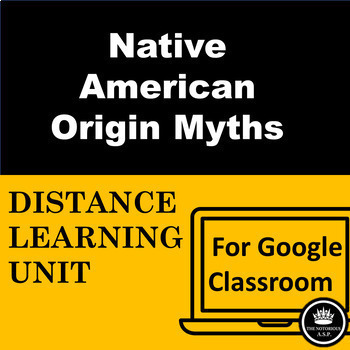Distance Learning Native American Origin Myths Unit for Google Classroom
- Zip
- Google Apps™

Description
7 to 8-day (or longer) COMPLETE unit with pacing guide (For Google Classroom)
What’s Included:
1. Introduction to the Unit: Instructional YouTube video covers 16-slide PPT Presentation that lays the foundation. Students watch and analyze a popular TV ad to learn how to discover characteristics of American culture and how to use the graphic organizers in this unit. Students are prepared to transfer the skills learned in this lesson to study Native American origin myths. Keys included. (Be sure your school doesn't block YouTube videos).
2. “Earth on Turtle’s Back” & “When Grizzlies Walked Upright” Creation Origin Myths
Students independently complete graphic organizers and discover for themselves archetypes and the characteristics of the Onondaga and Modoc cultures. Both myths are in many textbooks. To create this resource, I used “EoTB” as retold by Michael Caduto & Joseph Bruchac; “WGWU” as retold by Richard Erdoes & Alfonso Ortiz. These versions can be found online. KEYS Included.
3. “Navajo Origin Myth”
Guided reading questions and graphic organizers are designed to help students notice repetition and patterns, and from there, cite textual support to make inferences about the Navajo culture. Includes Paragraph Assignment & Rubric. The resource is aligned with the myth as retold by Washington Matthews. Myth is in many textbooks. Keys Included.
4. Project
Fun assessment offers 5 options. (Corona virus update: Only assign individual option nos. 1, 2, or 4)
5. Extend the Lesson beyond 7-8 days
Includes Optional Differentiated Essay Questions with link to a common standardized essay rubric.
6. Instructions for Google Classroom
• Directions on How to Download and Add Your New Resource to Your Google Drive
• Directions on how to Assign Resource to Google Classroom
* Notes: This resource is made with Google Slides & is NOT editable. Students type answers to questions in text boxes.
**Note: This resource is nearly identical to Native American Creation Origin Myth Complete Bundle, which is (1) for Google Classroom, (2) contains printable PDFs, (3) includes tips on how to establish a positive classroom culture. The resource you are viewing costs a few cents less because (1) it does NOT include the positive classroom culture tips, and (2) the printable PDF font is very large. The better value is the Native American Creation Origin Myth Complete Bundle
7. Standards
· Resource includes CCSS & New Jersey Student Learning standards in word.
8. Add How to Organize a Compare and Contrast Essay. Block and Point-by-Point Methods. One model is based on "When Grizzlies Walked Upright" and "Earth on Turtle's Back." Great for edTPA Secondary ELA English candidate's 3-day lesson segment (language function (syntax)).
* Note: The myths themselves are NOT included with this resource.
Thanks for stopping by!




